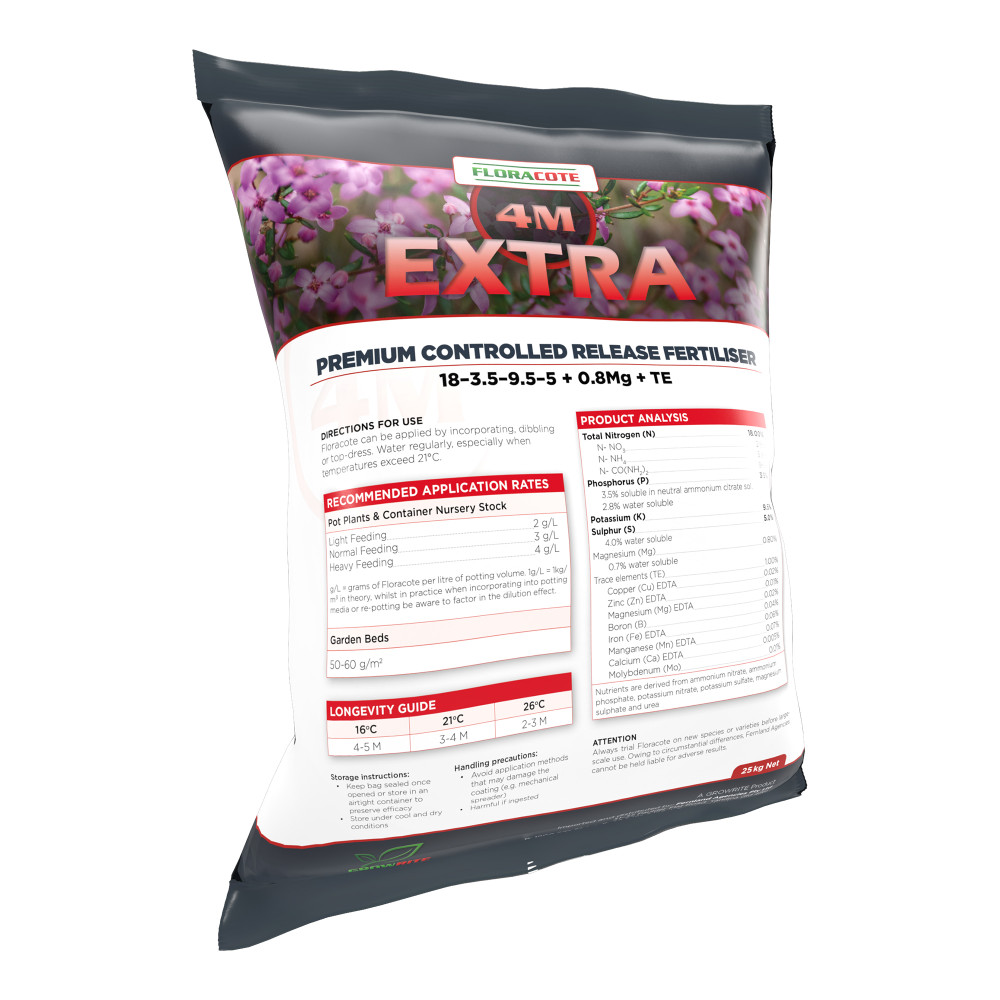Description
THIS PRODUCT:
- Full spec product with trace elements (18-3.5-9.5 + Trace Elements – see label for full analysis)
- The release time is not affected by substrate type, pH, microorganisms, level of irrigation or soil moisture
- FloraCote® starts to release after 2-3 weeks. Due to this specific mechanism the product is very safe to crops
- Release of nutrients is attuned to physiological requirements of the crops
- Minimised nutrient losses
- Strict quality control
- Highest safety for your crops
- Exclusive to Fernland
- Made specifically to our strict specifications and analysis
In General: A 4-month controlled-release fertilizer is a type of plant nutrient product designed to provide essential nutrients to plants gradually over a period of approximately four months. These fertilizers are formulated to release nutrients slowly and steadily, ensuring that plants receive a consistent supply of the necessary elements for healthy growth. Here’s a description of 4-month controlled-release fertilizers and their common uses:
Description: A 4-month controlled-release fertilizer typically comes in the form of granules or pellets. These granules are coated with a special polymer or resin that regulates the release of nutrients into the soil. The coating is designed to break down gradually, allowing nutrients to be released at a controlled rate over the specified period, which is typically around four months. Key characteristics of these fertilizers include:
- Slow and Steady Nutrient Release: The controlled-release technology ensures that nutrients are not quickly leached away by rain or irrigation, reducing the risk of over-fertilization and minimizing environmental impact.
- Balanced Nutrient Composition: These fertilizers are formulated with a balanced mix of essential nutrients, including nitrogen (N), phosphorus (P), and potassium (K), as well as secondary and micronutrients. This balanced composition supports overall plant health.
- Convenience: Controlled-release fertilizers require fewer applications compared to conventional fertilizers, reducing the frequency of fertilization and simplifying maintenance for home gardeners and landscapers.
Uses:
- Landscaping and Gardening: Four-month controlled-release fertilizers are widely used in landscaping and gardening to provide nutrients to ornamental plants, shrubs, trees, and lawns. They offer an extended nutrient supply, reducing the need for frequent reapplication.
- Container Gardening: These fertilizers are suitable for potted plants and container gardens, as they release nutrients gradually, ensuring that container plants receive consistent nourishment.
- Agriculture: In agricultural settings, controlled-release fertilizers can be applied to field crops, fruit orchards, and vegetable gardens to provide nutrients throughout the growing season, reducing the labor and costs associated with multiple fertilizer applications.
- Greenhouses: Controlled-release fertilizers are used in greenhouse operations to promote the healthy growth of greenhouse-grown crops, such as tomatoes, peppers, and ornamental plants.
- Nurseries: Commercial plant nurseries use these fertilizers to supply nutrients to nursery stock and young plants, ensuring they are well-nourished during their early growth stages.
- Extended Feeding: These fertilizers are particularly useful in situations where plants require nutrients over an extended period, such as newly planted trees and shrubs or slow-growing perennial flowers.
- Reducing Environmental Impact: Controlled-release fertilizers help reduce the potential for nutrient runoff into water bodies and minimize the risk of nutrient leaching into groundwater, making them an environmentally friendly choice.
Overall: When using a 4-month controlled-release fertilizer, it’s important to follow the manufacturer’s recommendations for application rates and guidelines, as different products may have varying formulations and release rates. Proper placement of the fertilizer in the root zone of the plants is crucial to ensure effective nutrient delivery. Additionally, consider conducting soil tests to determine specific nutrient needs and to avoid over-fertilization.


